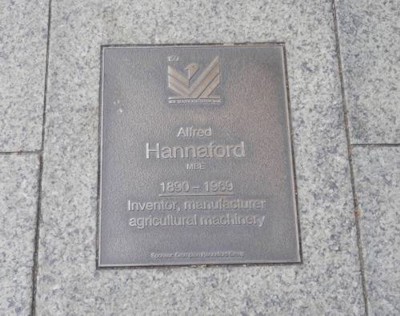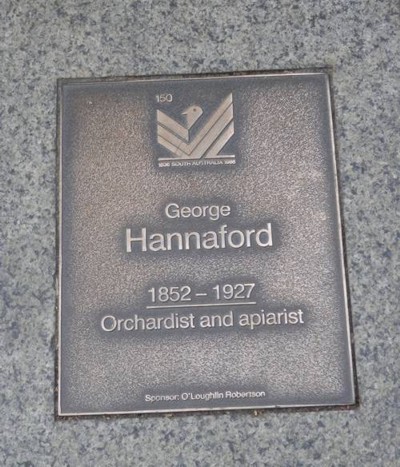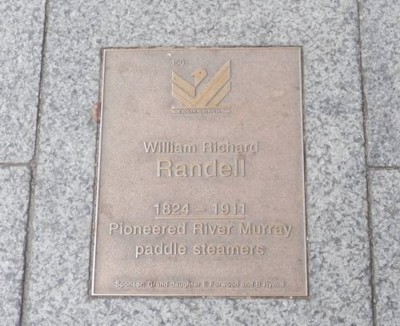History Under Your Feet
North Terrace is a major road right in the heart of Adelaide, South Australia, yet I’m amazed at the number of people who don’t even know that the plaques are there. These represent the many men and women who helped make South Australia as it is, and they are right there on the footpath under your feet.
Heading over to Wikipedia they explain the plaques as …
The Jubilee 150 Walkway, also variously known as the Jubilee 150 Commemorative Walk is a series of (initially) 150 bronze plaques set into the pavement of North Terrace, Adelaide. It was officially opened on 21 December 1986. It was commissioned as part of the celebrations commemorating the 150th anniversary of the founding of the state of South Australia. The plaques contain the names and deeds of (initially) 170 people who made major contributions to the founding and development of South Australia. Since 1986, the Adelaide City Council has added four plaques. The plaques are arranged in alphabetic order, and stretch from King William Street to Pulteney Street along the north side of North Terrace.
Anyway on a recent trip into the city I took the opportunity to photograph the plaques of my reli’s.
So here’s the story of my reli’s on the North Terrace plaques:
===========================================================
ALFRED HANNAFORD (1890-1969)
Alfred Hannaford’s claim to fame was that he was an inventor of farm machinery. It was in 1914, when Alfred was only 24 years old he attended a farmers’ conference, saw a machine for the treatment of seed wheat against the parasitic fungal diseases, and he decided he could make a better one. So, he did. He devised the first mechanical wet pickling machine.
In 1915 production of the machines began, and they proved incredibly popular, and more agricultural machinery followed.
Then the Depression came, and farmers couldn’t afford to buy Hannaford’s products, so he mounted his machines on trucks and sent them travelling around the State, preparing the seed for farmers on a contract basis,, and by 1933 two hundred of these trucks were on the road, and by 1937 branches of the company were opened in Victoria and Western Australia.
Alfred Hannaford retired as Managing Directory in 1960 and in that same year was given an M.B.E. for his services to agriculture. Alfred died in 1969 and he bequeathed over $300,000 to the Waite Agricultural Research Institute to support further agricultural research, the Hannaford Building at the Institute is named in his honour.
After his death the company was taken over by other firms, and in 1987 was renamed Hannaford Seedmasters Services, with its core business still the mobile grading fleet which operates in essentially the same manner as Alfred intended back in 1929.
===========================================================
GEORGE WILLIAM HANNAFORD (1852-1927)
The Hannaford family made a prominent contribution to local affairs and to the horticultural industry around Gumeracha and Cudlee Creek. George Williams Hannaford (father of George William) was one of the pioneer apple growers of the colony, and also planted a vineyard, grew wheat and grazed cattle. And he is reputed to have built the first haystack in South Australia.
During his younger years George jnr actively assisted his dad and brothers in the orchard and on the farm which would have given him invaluable experience, as in 1873 he obtained his own farm land on Yorke Peninsula and took a prominent role in the formation of a local branch of the Agricultural and Horticultural Society.
In 1876 George married Bertha Hayler Whibly (nee Linfield) and they had three sons and three daughters. In 1880 the family resetted at ‘Dingo Vale’ near Cudlee Creek, where he planted apples and pears and got into exporting them. He planted more than 100 acres of orchards and in 1896 successfully exported apples to England, Germany and South Africa. These were packed by his sons, and on arrival at the overseas destination commanded high prices.
While pursuing apple growing, George jnr established his ‘Gipsy Apriary’which comprised several hundred bee-hives housing queen bees imported from Itlay. And as such he pioneered the production of honey in the Adelaide Hills.
So while it’s very cool that my reli’s were pioneers in the apple growing field, not to mention exporting and bee-keeping – it’s very cool that six generations later there are still Hannaford’s in the region, and still growing apples.
===========================================================
WILLIAM RICHARD RANDELL (1824-1911)
“Pioneer of River Murray Paddle-Steamers”. William Richard Randell is the half-brother of my great grandpa John Beavis Randell. William Richard Randell was born in Devon, England and emigrated with his parents to South Australia in 1837. It wasn’t too long before his father took up land at Gumeracha in the Adelaide Hills where he built a flour mill.
William R. Randell, along with his father held land along the banks of the Murray River and it was while minding cattle that he became determined to be the first man to put a steamboat on the river.
In 1852 after hearing about the goldrush in Victoria he decided it was time to make his dream happen, and without ever having seen a steamboat, he, together with his brothers and some carpenters to make it happen. The engine was built by a German engineer, and the boiler was designed by Randell himself and made by a local blacksmith. The “‘Mary Ann” (named after his mother) was completed in 1853, and in March made it’s first successful run.
Over the next few decades William married, had a growing family, increased his fleet of paddlesteamers that was used to freight cargo up and down the River Murray, and moved from Gumeracha, South Australia to Wentworth, New South Wales, then to Mannum, South Australia and back to Gumeracha.
William was also quite into the political scene, and in 1893 through to 1899 he represented Gumeracha in the House of Assembly. And records show that he favoured water conservation and irrigation, village settlements, working men’s blocks, and women’s suffrage, but was opposed to protection and taxation change. William Richard died on 4 March 1911 and is buried at the Salem Baptist Church cemetery, along with many other members of his family.
===========================================================
So that’s the short story of my three reli’s who helped make South Australia in some way. There are 170 or so plaques, think of all the interesting stories behind each one of them.








A great read Alona!! One of my very distant ancestors Eliezer Hainsworth Dodd would have known William Randell as he was also a paddlesteamer builder and captain. He lived at Goolwa and built the PS Mundoo.